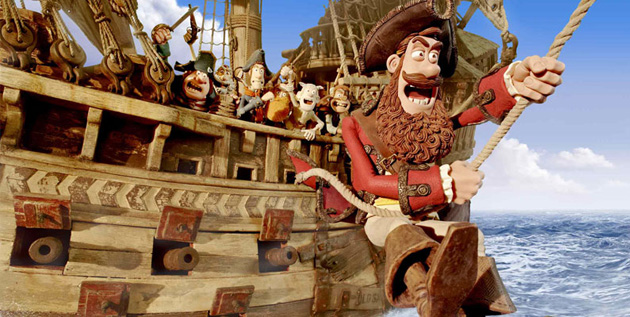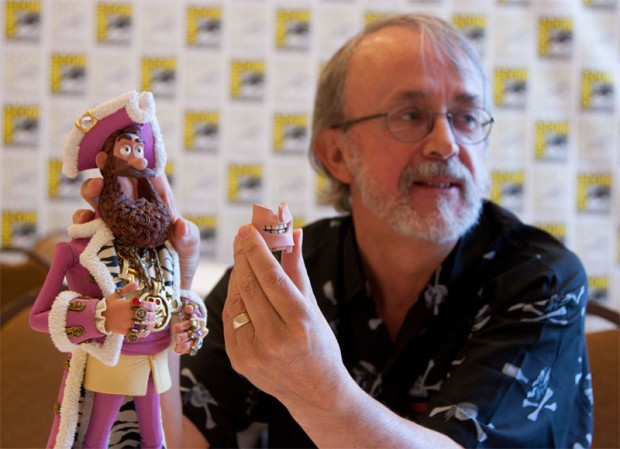
I first fell in love with Aardman Animations when Wallace & Gromit: The Curse of the Were-Rabbit arrived in 2005. Since then they’ve had some ups and downs but their latest is a gem. Co-founder Peter Lord is back in the director’s chair for The Pirates! Band of Misfits, which also marks their first foray into 3D. While that technology is still lacking effectiveness since the post-Avatar market, the film is still a delight. Last month I had the great pleasure of sitting down with Peter Lord for a roundtable interview. We touched on how he got a song from Flight of the Conchords into the film, using CG to populate the crowds, casting Hugh Grant as Pirate Captain, and much more.
The Film Stage: The first thing that jumps out at you about the movie is that it is such a complicated claymation thing. There is CGI elements and there was talk about doing it in CGI at some point. How did that all fall out to the point where you said ‘we are going to tackle this’?
Peter Lord: There was talk about doing it in CG, originally. That was kind of strategic rather than artistic because when was the studio free? We made a set, very early on, because I didn’t know how to design it otherwise. We built a set as a design project, actually. The Captain’s cabin. It was so convincing, so compelling in 3D, as a proper animation, everyone said that it was so obvious… it’s got to be done this way. Which is good, because that’s what i wanted, really. I got what I wanted. It’s a very elaborate production, for sure. I hope it doesn’t seem labored or anything like that. But it is elaborate.
It’s the biggest thing we’ve ever done. I bet it’s the biggest stop motion film that’s ever been in terms of its scale and its ambition. The number of characters in it. And that’s why we used CG characters—to flesh out the world—because it’s very difficult and very expensive to do crowds in stop motion. Of all things, it’s the thing you avoid the most. A moderately small crowd, like 200 people, in live-action you can get 200 extras very easily. But 200 puppets… you have to build them all. Which is expensive. Each one costs some number of thousands of pounds to build. So either you build 200 or else you’ve got 20 and you have to shoot them ten times and pop around the set in different locations. And then that takes you forever to shoot. So, bottom line is we went with CG background characters.
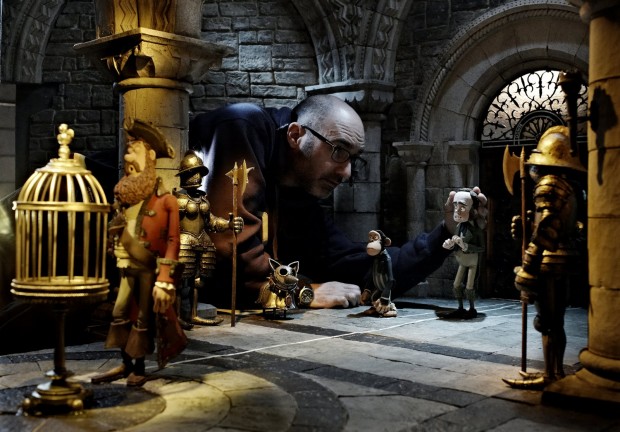
Did you find any difficulty in adapting the stop motion process to shooting in 3D at all?
No, it was quite easy. I thought it would be difficult. We were worried in advance. ‘Oh God, this is going to add 50% to the budget and take forever.’ But actually, in the event, it was really pretty easy to do. The moment you take a frame, you always have a still camera and a still background. That’s kind of how it is. Even though the optical illusion is that we have a very dynamic camera and dynamic background. But it’s actually still. So you take one frame for the right eye and then the camera slides across and takes one for the left eye. And then back to position again.
So for every single frame of film, you take two frames, one from each of the eye’s point of view. And the interesting thing, technically, is that in a regular 3D film, the two viewpoints are three or four inches apart. To imitate the distance apart of human eyes. That’s how we see the world. And we experimented with that. But that didn’t look right at all, so we limited the distance apart from the two viewpoints to only half an inch apart based on how far apart the puppet’s eyes are. So you felt you were the same size of the puppets rather than giants. Rather than giants looking down at puppets you felt you were in their world. It was really interesting.
And the water had to be CGI.
It was CGI, yes. I have seen films that stylized water so you could have animated it by hand. Actually, to be honest I’ve never seen it done, but a film like James and the Giant Peach did it, and so did that Finding Neverland film with Johnny Depp. In both of those films they made it look like it was mechanical, but still it was CG because it’s too mind boggling to make a mechanical motion of the sea. Beyond imagination. So I didn’t even try. We went for CG sea. But we did stylize the sea. The funny thing is that whenever anyone makes a sea or an ocean for a CG film, they always start from scratch. You’d think by now you could just buy it off the Internet. But for every studio they’ve invented their own sea, so that’s what my guys did. They had to go back to first principals and invent it again. But they stylized it to make it match as well as it possibly can. Slightly larger particles than is real. Simpler wave patterns.
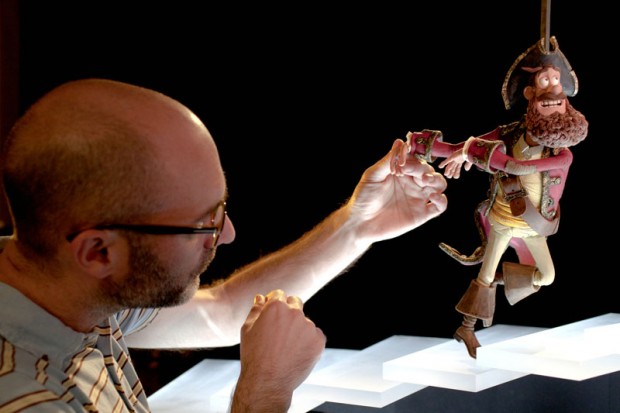
Did the logistics of any of the set pieces you were going for end up being changed because you are doing this in stop motion? Did you have to scrap any or did you just have to tweak them to make them feasible?
It was the latter. We do tweak things a little bit. In stop motion, you’re not quite as free as you are in CG. No, you’re not. So there are limitations. We fight them every inch of the way. [Laughs] And we’re always pushing the envelope and trying to get more, more, more from the shots that we do shoot. There’s a ridiculous chase downstairs in the bath and I don’t think that was compromised at all. Here’s an interesting point. Everything we wanted to do was done in stop frame. Interesting thing is, though, that the way it was designed for stop frame. That chase, you know. Knowing that we could play into our strengths. And we did the classic cartoon thing, ever since Tom & Jerry, of making the house infinitely huge.
From the outside, the camera tells you it’s four stories high, but inside it must be at least 20 stories high. Who cares, because it’s fun. It’s fun. And actually, that, I suspect, is slightly easier in stop frame than it is in CG. Because I’ve worked on CG films and the thing that always freaks them out in the world of CG is cheating. They don’t like cheating. It’s hard to cheat. Whereas we can say ‘yes, that room was 12 feet long last time you saw it, but now it’s 30 feet long.’ We can do that, you know? Just by building it again. And they find that quite hard to do. I think we used the best of the technology there. Although we were a bit limited, generally speaking, shooting digitally—green screen—for lots of the exteriors, I found fantastically liberating as a director. It allowed me great freedom with the camera.
Was there a specific reason you waited this long to take on another director’s project? Or were you just waiting for the right one to come along?
Partly that, and… I did find myself inadvertently becoming a producer, which I didn’t really look for. Just happened. ‘Oh, no. Now I’m a producer. How did that happen?’ [All laugh] And I always wanted to direct. But it was the project that made me jump up and think, ‘Wow, I better do this now. This is the one.’ And if I don’t do this, am I going to be a producer for the rest of my life? Which I don’t want to be. So I grabbed the moment. I saw this book—and this is based on a book—and thought it was exceptionally funny. Like a revelation in terms of comedy, style, and tone. And I grabbed it. First of all, I said ‘I think we should make a film out of this.’ And then a beat later, ‘And I think I should do it.’ [All laugh] And I’m the boss, so that was alright.
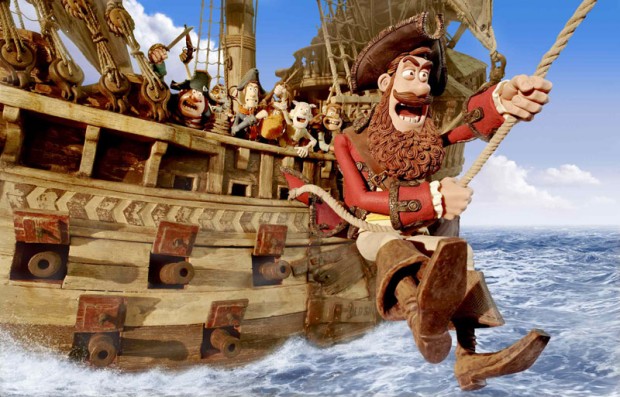
But it’s the time commitment too, isn’t it? The notes in the [press packet] says one sequence took 18 months. The bar scene?
It was 18 months.
That’s incredible.
Yeah, it is a long time, isn’t it? And I think it mentions the one guy who got married and had a baby while he was doing it. Chris Sadler, I think he was called. He was an animator. He joined the production and went into the tavern, and he didn’t come out until the end. And in the meantime he got married and had a baby. And he didn’t even do the whole scene because other guys did bits of it. But he did most of the scenes. He did about two-thirds of it, and the other animators did the other [third] And although it may sound scary to a lot of people, it’s actually really good.
Here’s the thing, again, that we can do that they don’t do in CG: one animator can follow a scene right through with great continuity.Which is very nice. In the world of CG, they tend to pluck shots out of the air and different people are animating consecutive shots the whole time. But we had the luxury that we could a guy named Andy and a guy named Chris, and we could put them in the tavern and say, ‘These performances are yours.’ So they could just develop that scene, land that scene, and know it intimately. Chris, who is the one who spent most of the time there, is quite the exceptional animator. He had fun—maybe for his own sanity—inventing little backstories for the people in the background.
There’s a guy in the background who’s clearly ordered a drink and then when he looks into it he finds something unspecified floating in the drink which he doesn’t like the look of. So he calls the barmaid back to get a replacement. Some other guys are playing cards in the background. And somebody’s cheating. They are extras so they aren’t meant to be intrusive, but it’s a big achievement.
One of my favorite parts of the movie is a song from this band called Flight of the Conchords. I’m just curious how you went about getting that and what their reaction to being approached for this.
The interesting thing is that this book, and this screenplay’s written by a guy named Gideon Defoe. He’s a young Englishman… I bet he’s about the same age as the Flight of the Conchords. They just share a sense of comedy. Just coincidentally. They didn’t know each other at all. They have a very similar sense of comedy. I was a big fan. I loved their show. Such a funny act they had. So, two things. One is that we approached them to write the title song. Never actually happened, unfortunately. We couldn’t get it right. We tried. We tried many times; couldn’t get it right. But we love their music. It’s hard to remember, but somebody went through their back catalog of music and found this song and put it in there, just in the early days.

Temp music.
Yeah, temp music. When it was all in drawings. Temp music, that’s right. Everyone just loved it. ‘That’s so charming. Well, we’ll stick with that.’ And we did, through thick and thin. Often in animated movies, you’ve got so long to make the movie that there’s a great danger that you undo good stuff. You have a great idea and everyone goes ‘Hahaha. That is a brilliant idea.’ Then you live with it for two years and at the end of two years you think, ‘That’s a crappy idea.’ [All laughs] So you have to say, ‘No, no, wait, we all loved that one. Have faith.’ So we stuck with it.
It’s funny, actually, because then we ended up with a music supervisor, who’s a guy basically who’s job is to offer up potential tunes and he offered up some straight sad songs, and they worked… of course they worked, but it was wrong for the film. So I’m so happy to have this witty sad song. There’s some great stuff in there. There’s The Clash in there and there’s also a song that I chose, in particular, that nobody notices. But it’s some crazy old coot, sitting on his front porch somewhere in the mountains in American in the 1920s playing a guitar and singing ‘I’m sailing on the ocean.’ It sounds like a million years old. Makes me laugh. So we had fun with the music.
You mentioned shared sense of humors, and it seems like Defoe’s sense of humor is so similar to your earlier work. There’s a lot of congruity there. Is that what really jumped out when you were looking at his book or how much of your own sense of humor were you able to direct into the book?
He has a particular skill. A great skill for absurdist comedy. And yet the modern tone as well. He’s younger than me so he’s got quite a bit more modern tone. I always felt like he was a huge asset to me. I love his comedy. I couldn’t have possibly written stuff like that. So I was just grateful for his inspirational comedy. But I thought we were a really great team. He didn’t think very visually. So I was constantly pushing back at him about that. I mean, ‘hey, this is a movie.’ It can’t all just be people saying funny things to each other. [All laugh] ‘We’ve got to really push this.’ And I had a particularly great storyboard team. In animation, the storyboard team come up with brilliant ideas. So they were valuable. I felt, and I still feel, like there is a really excellent team effort of Gideon and me, the story team, and then all the animators and then all the actors. They’re all sort of contributing towards something that feels like a very coherent whole to me.
Could anybody have done it besides Hugh Grant?
Well. Technically they could, I suppose. But he was perfect for the job. He was absolutely perfect. I wanted like a star. I did have ambition. I thought we needed a big performance at the heart of this. And I thought also, frankly, for the movie to have some substance, it helps to have a star attached. And I wanted him to be English, because Gideon’s writing is very English. Or, no, it’s not the style, it’s the delivery. The way you deliver a gag is English phrasing. So I wanted an English actor. I mean Johnny Depp could have done it, actually. But he was otherwise committed to the pirate business. So, an English leading man. You can imagine he’s at the top of my list of half a dozen candidates. But then a funny leading English man. There weren’t so many candidates, suddenly. Really, it was just Hugh. And I always loved About a Boy. Such a funny film. Not roaring out loud funny, but just take a situation that is profoundly comic and play it out. So I was thinking about that. The business of roaring out orders from the quarter deck was different for Hugh but I think he loved it.
The Pirates! Band of Misfits is now in wide release.

